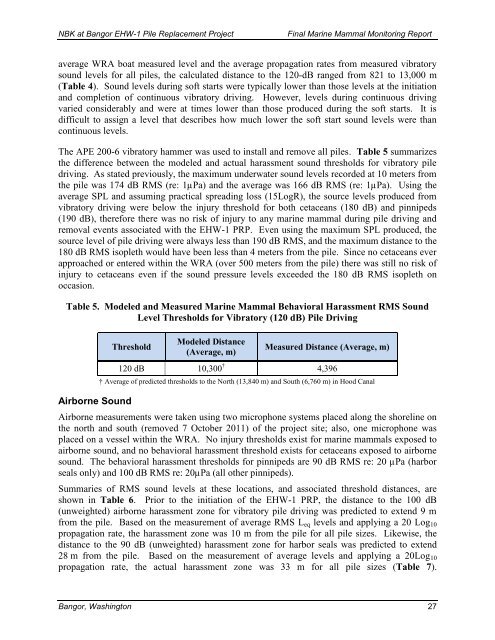Section 1 Introduction - National Marine Fisheries Service - NOAA
Section 1 Introduction - National Marine Fisheries Service - NOAA
Section 1 Introduction - National Marine Fisheries Service - NOAA
Create successful ePaper yourself
Turn your PDF publications into a flip-book with our unique Google optimized e-Paper software.
NBK at Bangor EHW-1 Pile Replacement Project Final <strong>Marine</strong> Mammal Monitoring Report<br />
average WRA boat measured level and the average propagation rates from measured vibratory<br />
sound levels for all piles, the calculated distance to the 120-dB ranged from 821 to 13,000 m<br />
(Table 4). Sound levels during soft starts were typically lower than those levels at the initiation<br />
and completion of continuous vibratory driving. However, levels during continuous driving<br />
varied considerably and were at times lower than those produced during the soft starts. It is<br />
difficult to assign a level that describes how much lower the soft start sound levels were than<br />
continuous levels.<br />
The APE 200-6 vibratory hammer was used to install and remove all piles. Table 5 summarizes<br />
the difference between the modeled and actual harassment sound thresholds for vibratory pile<br />
driving. As stated previously, the maximum underwater sound levels recorded at 10 meters from<br />
the pile was 174 dB RMS (re: 1µPa) and the average was 166 dB RMS (re: 1µPa). Using the<br />
average SPL and assuming practical spreading loss (15LogR), the source levels produced from<br />
vibratory driving were below the injury threshold for both cetaceans (180 dB) and pinnipeds<br />
(190 dB), therefore there was no risk of injury to any marine mammal during pile driving and<br />
removal events associated with the EHW-1 PRP. Even using the maximum SPL produced, the<br />
source level of pile driving were always less than 190 dB RMS, and the maximum distance to the<br />
180 dB RMS isopleth would have been less than 4 meters from the pile. Since no cetaceans ever<br />
approached or entered within the WRA (over 500 meters from the pile) there was still no risk of<br />
injury to cetaceans even if the sound pressure levels exceeded the 180 dB RMS isopleth on<br />
occasion.<br />
Table 5. Modeled and Measured <strong>Marine</strong> Mammal Behavioral Harassment RMS Sound<br />
Level Thresholds for Vibratory (120 dB) Pile Driving<br />
Threshold<br />
Airborne Sound<br />
Modeled Distance<br />
(Average, m)<br />
Measured Distance (Average, m)<br />
120 dB 10,300 † 4,396<br />
† Average of predicted thresholds to the North (13,840 m) and South (6,760 m) in Hood Canal<br />
Airborne measurements were taken using two microphone systems placed along the shoreline on<br />
the north and south (removed 7 October 2011) of the project site; also, one microphone was<br />
placed on a vessel within the WRA. No injury thresholds exist for marine mammals exposed to<br />
airborne sound, and no behavioral harassment threshold exists for cetaceans exposed to airborne<br />
sound. The behavioral harassment thresholds for pinnipeds are 90 dB RMS re: 20 µPa (harbor<br />
seals only) and 100 dB RMS re: 20µPa (all other pinnipeds).<br />
Summaries of RMS sound levels at these locations, and associated threshold distances, are<br />
shown in Table 6. Prior to the initiation of the EHW-1 PRP, the distance to the 100 dB<br />
(unweighted) airborne harassment zone for vibratory pile driving was predicted to extend 9 m<br />
from the pile. Based on the measurement of average RMS Leq levels and applying a 20 Log10<br />
propagation rate, the harassment zone was 10 m from the pile for all pile sizes. Likewise, the<br />
distance to the 90 dB (unweighted) harassment zone for harbor seals was predicted to extend<br />
28 m from the pile. Based on the measurement of average levels and applying a 20Log10<br />
propagation rate, the actual harassment zone was 33 m for all pile sizes (Table 7).<br />
Bangor, Washington 27
















